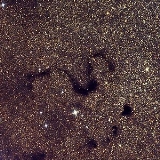
Snake Nebula
Encyclopedia
The Snake Nebula is a dark nebula
in the Ophiuchus constellation
. It is a small but readily apparent S-shaped dust lane that snakes out in front of the Milky Way star clouds from the north-north-west edge of the bowl of the Pipe Nebula
. Its thickness runs between 2′ and 3′ and runs around 6′ in the north-west / south-east orientation. A good view in a 4" to 6" telescope requires clear dark skies.
It is part of the much larger Dark Horse Nebula
.
To the right side of the Snake Nebula is found Barnard 68
. Below it are found Barnard 69, Barnard 70, and Barnard 74.
Nebula
A nebula is an interstellar cloud of dust, hydrogen gas, helium gas and other ionized gases...
in the Ophiuchus constellation
Ophiuchus
Ophiuchus is a large constellation located around the celestial equator. Its name is from the Greek "serpent-bearer", and it is commonly represented as a man grasping the snake that is represented by the constellation Serpens. Ophiuchus was one of the 48 constellations listed by the 2nd-century...
. It is a small but readily apparent S-shaped dust lane that snakes out in front of the Milky Way star clouds from the north-north-west edge of the bowl of the Pipe Nebula
Pipe Nebula
The Pipe Nebula is a dark nebula in the Ophiuchus constellation. It is a large but readily apparent pipe shaped dust lane that obscures the Milky Way star clouds behind it...
. Its thickness runs between 2′ and 3′ and runs around 6′ in the north-west / south-east orientation. A good view in a 4" to 6" telescope requires clear dark skies.
It is part of the much larger Dark Horse Nebula
Dark Horse (astronomy)
The Dark Horse Nebula or Great Dark Horse is a large dark nebula, which as seen from Earth, obscures part of the upper central bulge of the Milky Way...
.
To the right side of the Snake Nebula is found Barnard 68
Barnard 68
Barnard 68 is a molecular cloud, dark absorption nebula or Bok globule, towards the southern constellation Ophiuchus and well within our own galaxy at a distance of about 500 light-years, so close that not a single star can be seen between it and the Sun. American astronomer Edward Emerson Barnard...
. Below it are found Barnard 69, Barnard 70, and Barnard 74.

